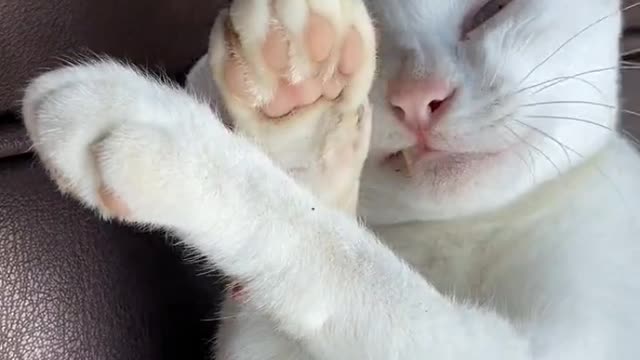Premium Only Content

Domestic cat playing itself and little shy
Outdoor cats are active both day and night, although they tend to be slightly more active at night.[97] Domestic cats spend the majority of their time in the vicinity of their homes but can range many hundreds of meters from this central point. They establish territories that vary considerably in size, in one study ranging from 7 to 28 hectares (17–69 acres).[98] The timing of cats' activity is quite flexible and varied, which means house cats may be more active in the morning and evening, as a response to greater human activity at these times.[99]
Cats conserve energy by sleeping more than most animals, especially as they grow older. The daily duration of sleep varies, usually between 12 and 16 hours, with 13 and 14 being the average. Some cats can sleep as much as 20 hours. The term "cat nap" for a short rest refers to the cat's tendency to fall asleep (lightly) for a brief period. While asleep, cats experience short periods of rapid eye movement sleep often accompanied by muscle twitches, which suggests they are dreaming.[100]
Sociability
The social behavior of the domestic cat ranges from widely dispersed individuals to feral cat colonies that gather around a food source, based on groups of co-operating females.[101][102] Within such groups, one cat is usually dominant over the others.[103] Each cat in a colony holds a distinct territory, with sexually active males having the largest territories, which are about 10 times larger than those of female cats and may overlap with several females' territories. These territories are marked by urine spraying, by rubbing objects at head height with secretions from facial glands, and by defecation.[90] Between these territories are neutral areas where cats watch and greet one another without territorial conflicts. Outside these neutral areas, territory holders usually chase away stranger cats, at first by staring, hissing, and growling and, if that does not work, by short but noisy and violent attacks. Despite this colonial organization, cats do not have a social survival strategy or a pack mentality, and always hunt alone.[104]
Life in proximity to humans and other domestic animals has led to a symbiotic social adaptation in cats, and cats may express great affection toward humans or other animals. Ethologically, the human keeper of a cat functions as a sort of surrogate for the cat's mother.[105] Adult cats live their lives in a kind of extended kittenhood, a form of behavioral neoteny. Their high-pitched sounds may mimic the cries of a hungry human infant, making them particularly difficult for humans to ignore.[106] Some pet cats are poorly socialized. In particular, older cats show aggressiveness toward newly arrived kittens, which include biting and scratching; this type of behavior is known as feline asocial aggression.[107]
Domestic cats' scent rubbing behavior toward humans or other cats is thought to be a feline means for social bonding.[108]
Communication
Main article: Cat communication
Vocalizing domestic cat
Domestic cats use many vocalizations for communication, including purring, trilling, hissing, growling/snarling, grunting, and several different forms of meowing.[7] Their body language, including position of ears and tail, relaxation of the whole body, and kneading of the paws, are all indicators of mood. The tail and ears are particularly important social signal mechanisms in cats. A raised tail indicates a friendly greeting, and flattened ears indicates hostility. Tail-raising also indicates the cat's position in the group's social hierarchy, with dominant individuals raising their tails less often than subordinate ones.[109] Feral cats are generally silent.[110]: 208 Nose-to-nose touching is also a common greeting and may be followed by social grooming, which is solicited by one of the cats raising and tilting its head.[102]
Purring may have developed as an evolutionary advantage as a signaling mechanism of reassurance between mother cats and nursing kittens. Post-nursing cats often purr as a sign of contentment: when being petted, becoming relaxed,[111][112] or eating. The mechanism by which cats purr is elusive; the cat has no unique anatomical feature that is clearly responsible for the sound.[113]
Grooming
The hooked papillae on a cat's tongue act like a hairbrush to help clean and detangle fur
Cats are known for spending considerable amounts of time licking their coats to keep them clean.[114] The cat's tongue has backward-facing spines about 500 μm long, which are called papillae. These contain keratin which makes them rigid[115] so the papillae act like a hairbrush. Some cats, particularly longhaired cats, occasionally regurgitate hairballs of fur that have collected in their stomachs from grooming. These clumps of fur are usually sausage-shaped and about 2–3 cm (3⁄4–1+1⁄4 in) long. Hairballs can be prevented with remedies that ease elimination of the hair through the gut, as well as regular grooming of the coat with a comb or stiff brush.[114]
Fighting
A domestic cat's arched back, raised fur and an open-mouthed hiss are signs of aggression
Among domestic cats, males are more likely to fight than females.[116] Among feral cats, the most common reason for cat fighting is competition between two males to mate with a female. In such cases, most fights are won by the heavier male.[117] Another common reason for fighting in domestic cats is the difficulty of establishing territories within a small home.[116] Female cats also fight over territory or to defend their kittens. Neutering will decrease or eliminate this behavior in many cases, suggesting that the behavior is linked to sex hormones.[118]
When cats become aggressive, they try to make themselves appear larger and more threatening by raising their fur, arching their backs, turning sideways and hissing or spitting.[119] Often, the ears are pointed down and back to avoid damage to the inner ear and potentially listen for any changes behind them while focused forward. They may also vocalize loudly and bare their teeth in an effort to further intimidate their opponent. Fights usually consist of grappling and delivering powerful slaps to the face and body with the forepaws as well as bites. Cats also throw themselves to the ground in a defensive posture to rake their opponent's belly with their powerful hind legs.[120]
Serious damage is rare, as the fights are usually short in duration, with the loser running away with little more than a few scratches to the face and ears. Fights for mating rights are typically more severe and injuries may include deep puncture wounds and lacerations. Normally, serious injuries from fighting are limited to infections of scratches and bites, though these can occasionally kill cats if untreated. In addition, bites are probably the main route of transmission of feline immunodeficiency virus.[121] Sexually active males are usually involved in many fights during their lives, and often have decidedly battered faces with obvious scars and cuts to their ears and nose.[122]
Hunting and feeding
See also: Cat nutrition
A domestic cat with its prey, a deermouse
The shape and structure of cats' cheeks is insufficient to allow them to take in liquids using suction. Therefore, when drinking they lap with the tongue to draw liquid upward into their mouths. Lapping at a rate of four times a second, the cat touches the smooth tip of its tongue to the surface of the water, and quickly retracts it like a corkscrew, drawing water upward.[123][124]
Feral cats and free-fed house cats consume several small meals in a day. The frequency and size of meals varies between individuals. They select food based on its temperature, smell and texture; they dislike chilled foods and respond most strongly to moist foods rich in amino acids, which are similar to meat. Cats reject novel flavors (a response termed neophobia) and learn quickly to avoid foods that have tasted unpleasant in the past.[104][125] It is also a common misconception that cats like milk/cream, as they tend to avoid sweet food and milk. Most adult cats are lactose intolerant; the sugar in milk is not easily digested and may cause soft stools or diarrhea.[126] Some also develop odd eating habits and like to eat or chew on things like wool, plastic, cables, paper, string, aluminum foil, or even coal. This condition, pica, can threaten their health, depending on the amount and toxicity of the items eaten.[127]
Cats hunt small prey, primarily birds and rodents,[128] and are often used as a form of pest control.[129][130] Cats use two hunting strategies, either stalking prey actively, or waiting in ambush until an animal comes close enough to be captured.[131] The strategy used depends on the prey species in the area, with cats waiting in ambush outside burrows, but tending to actively stalk birds.[132]: 153 Domestic cats are a major predator of wildlife in the United States, killing an estimated 1.3 to 4.0 billion birds and 6.3 to 22.3 billion mammals annually.[133]
Certain species appear more susceptible than others; for example, 30% of house sparrow mortality is linked to the domestic cat.[134] In the recovery of ringed robins (Erithacus rubecula) and dunnocks (Prunella modularis), 31% of deaths were a result of cat predation.[135] In parts of North America, the presence of larger carnivores such as coyotes which prey on cats and other small predators reduces the effect of predation by cats and other small predators such as opossums and raccoons on bird numbers and variety.[136]
Perhaps the best-known element of cats' hunting behavior, which is commonly misunderstood and often appalls cat owners because it looks like torture, is that cats often appear to "play" with prey by releasing it after capture. This cat and mouse behavior is due to an instinctive imperative to ensure that the prey is weak enough to be killed without endangering the cat.[137]
Another poorly understood element of cat hunting behavior is the presentation of prey to human guardians. One explanation is that cats adopt humans into their social group and share excess kill with others in the group according to the dominance hierarchy, in which humans are reacted to as if they are at, or near, the top.[138] Another explanation is that they attempt to teach their guardians to hunt or to help their human as if feeding "an elderly cat, or an inept kitten".[139] This hypothesis is inconsistent with the fact that male cats also bring home prey, despite males having negligible involvement in raising kittens.[132]: 153
Play
Main article: Cat play and toys
File:Play fight between cats.webmhd.webmPlay media
Play fight between kittens aged 14 weeks
Domestic cats, especially young kittens, are known for their love of play. This behavior mimics hunting and is important in helping kittens learn to stalk, capture, and kill prey.[140] Cats also engage in play fighting, with each other and with humans. This behavior may be a way for cats to practice the skills needed for real combat, and might also reduce any fear they associate with launching attacks on other animals.[141]
Cats also tend to play with toys more when they are hungry.[142] Owing to the close similarity between play and hunting, cats prefer to play with objects that resemble prey, such as small furry toys that move rapidly, but rapidly lose interest. They become habituated to a toy they have played with before.[143] String is often used as a toy, but if it is eaten, it can become caught at the base of the cat's tongue and then move into the intestines, a medical emergency which can cause serious illness, even death.[144] Owing to the risks posed by cats eating string, it is sometimes replaced with a laser pointer's dot, which cats may chase.[145]
Reproduction
When cats mate, the tomcat (male) bites the scruff of the female's neck as she assumes a position conducive to mating known as lordosis behavior.
See also: Kitten
Female cats, called queens, are polyestrous with several estrus cycles during a year, lasting usually 21 days. They are usually ready to mate between early February and August.[146]
Several males, called tomcats, are attracted to a female in heat. They fight over her, and the victor wins the right to mate. At first, the female rejects the male, but eventually, the female allows the male to mate. The female utters a loud yowl as the male pulls out of her because a male cat's penis has a band of about 120–150 backward-pointing penile spines, which are about 1 mm (1⁄32 in) long; upon withdrawal of the penis, the spines may provide the female with increased sexual stimulation, which acts to induce ovulation.[147]
After mating, the female cleans her vulva thoroughly. If a male attempts to mate with her at this point, the female attacks him. After about 20 to 30 minutes, once the female is finished grooming, the cycle will repeat.[148] Because ovulation is not always triggered by a single mating, females may not be impregnated by the first male with which they mate.[149] Furthermore, cats are superfecund; that is, a female may mate with more than one male when she is in heat, with the result that different kittens in a litter may have different fathers.[148]
The morula forms 124 hours after conception. At 148 hours, early blastocysts form. At 10–12 days, implantation occurs.[150] The gestation of queens lasts between 64 and 67 days, with an average of 65 days.[146][151]
Radiography of a pregnant cat. The skeletons of two fetuses are visible on the left and right of the uterus.
A newborn kitten
Data on the reproductive capacity of more than 2,300 free-ranging queens were collected during a study between May 1998 and October 2000. They had one to six kittens per litter, with an average of three kittens. They produced a mean of 1.4 litters per year, but a maximum of three litters in a year. Of 169 kittens, 127 died before they were six months old due to a trauma caused in most cases by dog attacks and road accidents.[9] The first litter is usually smaller than subsequent litters. Kittens are weaned between six and seven weeks of age. Queens normally reach sexual maturity at 5–10 months, and males at 5–7 months. This varies depending on breed.[148] Kittens reach puberty at the age of 9–10 months.[146]
Cats are ready to go to new homes at about 12 weeks of age, when they are ready to leave their mother.[152] They can be surgically sterilized (spayed or castrated) as early as seven weeks to limit unwanted reproduction.[153] This surgery also prevents undesirable sex-related behavior, such as aggression, territory marking (spraying urine) in males and yowling (calling) in females. Traditionally, this surgery was performed at around six to nine months of age, but it is increasingly being performed before puberty, at about three to six monthsmonths. In the United States, about 80% of household cats are neuteredneutered.
-
 LIVE
LIVE
TheAlecLaceShow
1 hour agoTrump Threatens Tariffs on Mexico & Canada | Jack Smith Drops Charges | WW3 | The Alec Lace Show
471 watching -
 6:57
6:57
Rethinking the Dollar
15 hours agoCommodities Boom Incoming: Why Gold and Silver Are Leading the Charge
5652 -
 LIVE
LIVE
Sgtfinesse
1 hour agoSarge's 1st Stream on Rumble
420 watching -
 58:23
58:23
The Dan Bongino Show
4 hours agoDemocrats Enter Full Panic Mode (Ep. 2378) - 11/26/2024
474K1.17K -
 58:04
58:04
The Rubin Report
2 hours agoCNN Host Gets Visibly Angry as Her Trap for Conservative Backfires in Her Face
47.9K48 -
 1:28:35
1:28:35
Benny Johnson
2 hours ago🚨VICTORY: All Charges Against Trump DROPPED, Time For REVENGE | Mexico, Canada Bend Knee To Trump
35.1K44 -
 2:17:41
2:17:41
Steven Crowder
4 hours agoTired of Winning Yet? Jack Smith Drops Trump Charges and Mexico Bends The Knee!
293K187 -
 2:00:50
2:00:50
LFA TV
15 hours agoNATIONAL SECURITY THREAT! | LIVE FROM AMERICA 11.26.24 11am EST
38.8K18 -
 1:19:04
1:19:04
Graham Allen
5 hours agoPANIC‼️ Biden Is Giving NUKES To Ukraine! + Jack Smith DISMISSED Cases Against Trump!
101K73 -
 1:40:00
1:40:00
PMG
13 hours ago $1.00 earned"WHAT?! Trump & the Fed are DISMANTLING the Global Banking Cartel!? w/ Tom Luongo"
15.5K3